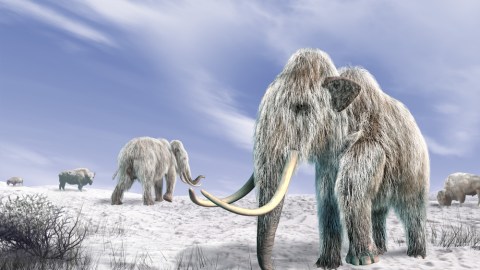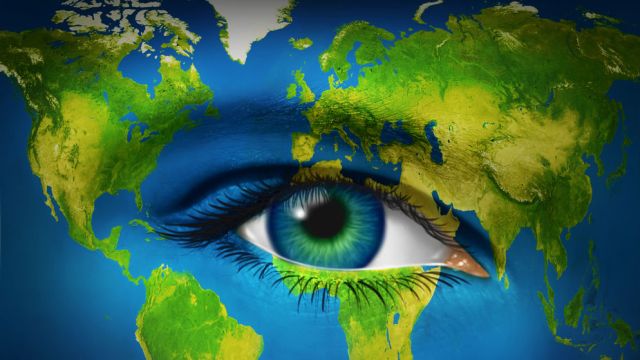The De-Extinction of the Wooly Mammoth Would Be an Evolutionary Mistake

Now that Russian scientists claim to have retrieved a vial of blood from a thawing wooly mammoth carcass from the permafrost of Siberia, the scientific community has been buzzing with speculation that we could finally be on the cusp of bringing the wooly mammoth back from extinction. But even if we could do that, would we want to?
Until now, the basic argument in favor of species de-extinction was that it offered humanity a chance to redeem itself for the wrongs committed over thousands of years. Humans, one could legitimately claim, have been mucking up the planet since time immemorial. As a result, many of the species that have been the targets of de-extinction efforts have been chosen because they seem to possess some basic fundamental right to survive. Often, they look much like species that have survived until today. If it hadn’t been for humans interfering with their natural habitats and delicate ecosystems, the argument goes, they would have been flourishing today.
Take the passenger pigeon, for example. Until 1914, the passenger pigeon was among the most plentiful species on the planet, numbering in the billions. Along the Eastern seaboard, residents could look up into the sky and see flocks of them flying overhead in such numbers that the skies went almost completely dark. And then humans got involved. Within a span of 25 years, the passenger pigeon had gone extinct, due primarily to commercial hunting and exploitation (e.g. passenger pigeon feathers were used for things like mattress filling). As a result, humans should feel at least a tinge of regret for wiping out the passenger pigeon.
But that same argument – a chance to redeem human wrongdoings over a wrongful extinction – doesn’t hold in the case of the wooly mammoth. The wooly mammoth, with its massive hair coat to preserve warmth, stood no chance for survival once the Ice Age ended. As Darwin first theorized, evolution is like an algorithm followed by nature. If an adaptation helps a species to survive and prosper, the adaptation will stick. If it doesn’t, it will eventually disappear from the gene pool. For better or for worse, certain species will go extinct when they can no longer adapt to their environment. It wasn’t just that wooly mammoths had heavy hair coats – they had all sorts of other adaptations that helped them thrive during the Ice Age, like huge tusks to clear away snow and ice. Bringing back the wooly mammoth would be tantamount to bringing back a species that deserved to go extinct.
To get around this argument, though, some scientists are starting to make the case that it wasn’t Mother Nature who did in the wooly mammoth — it was humans. Once the planet started to thaw out, humans came into contact with the wooly mammoth in greater numbers, and began to hunt them ruthlessly for their meat, bones and even skin. It’s essentially the passenger pigeon thesis, extended to the wooly mammoth. De-extinction fans will surely tell you that humans bear a type of evolutionary guilt for having wiped out the wooly mammoth, never mind climate change.
Yes, de-extinction is a mind-blowing concept and it’s easy to understand why a number of very smart scientists are leading the charge to bring back extinct species. Most of the folks who turned out for the TEDx De-Extinction event in Washington, D.C. in March seemed to be good-intentioned scientists who were genuinely excited by the advances in DNA sequencing and cloning. In this TEDx video, for example, Hendrik Poinar invokes our childlike sense of wonder, suggesting that the wooly mammoth was a kind of Ice Age Babar who took a few wrong steps and unfairly got wiped out.
Even if we go with the Jurassic Park scenario – creating a highly-controlled environment (i.e. a theme park) where the wooly mammoth could conceivably flourish – it doesn’t reason that you can simply hit the “rewind” button on evolution. As some conservationists are already warning, bringing back a species like the wooly mammoth could lead to the disappearance of other species who share similar habitats. Once you bring back a new species, you have to start thinking about ecosystem effects — and about Butterfly Effects. Bringing back the wooly mammoth would require massive changes to existing ecosystems.
As a society, we need to recognize that the de-extinction of the wooly mammoth would be an evolutionary mistake. Just because we can do something doesn’t mean that we should. We often assume that evolution works in a purposeful fashion – upward and onward, with each successive step bringing us that much closer to perfection and increasing complexity. However, evolution does not necessarily follow a linear progression, enabling us to neatly re-trace our steps. There are jagged steps, hints and feints, that are impossible to replicate by simply “evolving backwards.”
At the end of the day, de-extinction implies that scientists have a better algorithm than nature does for determining which species should flourish, and which ones should not. If that’s not scientific hubris, then what is? As a result, the looming battle over de-extinction might end up being one of the few times in the history of the world that scientists and Creationists can line up on the same sideline and root for the same team to win.
image: Wooly Mammoths on White Field / Shutterstock





